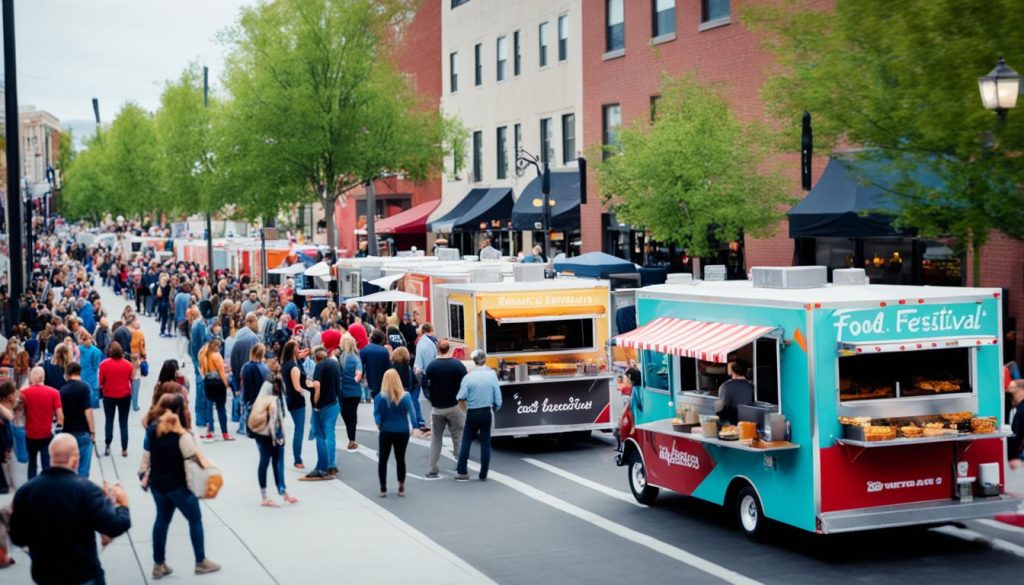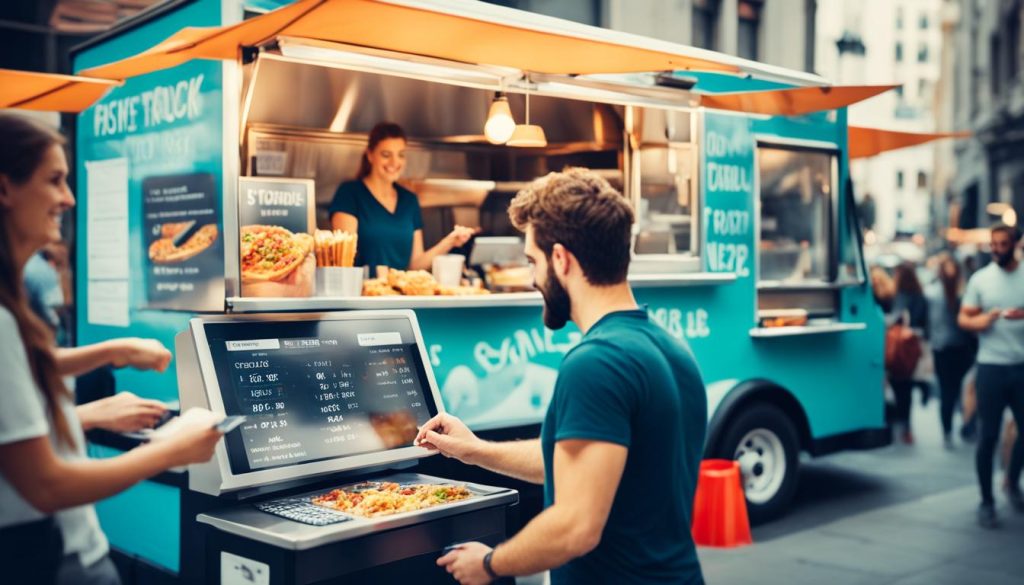Food trucks have become a popular choice for entrepreneurs in the food industry. With their mobility and lower startup costs compared to traditional restaurants, they offer an attractive opportunity to enter the market and reach a wide customer base. However, before diving into the world of food trucks, it’s essential to understand the earning potential and profitability factors that come into play.
When it comes to food truck revenue, several factors can impact how much they make. Location plays a crucial role, as being in a high-traffic area with a hungry customer base can significantly boost sales. Additionally, the menu and quality of the food offered, along with the pricing strategy, can influence customer demand and average sales per day.
Startup costs and ongoing expenses are also significant considerations when assessing the financial success of a food truck business. From purchasing or leasing a truck to obtaining licenses and permits, equipment costs, and insurance, these expenses can vary depending on location and specific requirements.
Profit margins are another critical factor to evaluate. By calculating the difference between revenue and operating expenses and expressing it as a percentage of revenue, you can assess the profitability of your food truck. Maximizing profit margins involves increasing revenue through effective marketing strategies and reducing costs through careful management of supplies, staffing, and operational efficiency.
Key Takeaways:
- The earning potential of food trucks depends on factors such as location, menu offerings, and pricing strategy.
- Startup costs for a food truck include purchasing or leasing a truck, obtaining licenses, permits, and insurance.
- Assessing profit margins is essential for determining the financial success of your food truck business.
- Increasing revenue and reducing costs are key strategies for maximizing profit margins.
- Thorough market research and planning can help improve the financial viability of your food truck.
Factors Affecting Food Truck Profitability
The profitability of a food truck is determined by several key factors that directly impact its earnings and overall success in the industry. These factors include:
- Startup Costs
- Monthly Expenses
- Profit Margins
- Location
- Competition
- Customer Demand
Understanding and effectively managing these factors is crucial for maximizing the profitability of your food truck business.
“The success and profitability of a food truck rely on careful consideration and strategic management of various factors that shape its financial performance.” – Food Industry Expert
Factors Impacting Food Truck Earnings
Startup costs play a vital role in determining how quickly a food truck can become profitable. These costs include purchasing or leasing a truck, outfitting it with necessary equipment, obtaining licenses and permits, and other initial expenses.
Monthly expenses encompass a wide range of costs, such as ingredients and supplies, staff wages, truck maintenance, insurance, marketing, and professional advice. Proper cost management is essential to maintain a healthy profit margin.
Profit margins are the difference between revenue and expenses. By optimizing these margins, food truck owners can increase profitability. This can be achieved through careful pricing strategies, managing operating costs, and identifying areas for cost reduction.
Location is a critical factor that impacts the success of a food truck. Choosing the right location with high foot traffic and a target audience interested in your cuisine increases the chances of attracting customers and generating consistent sales.
Competition within the food truck industry can significantly affect profitability. It is important to assess the competitive landscape and identify ways to differentiate your food truck by offering unique menu items, exceptional service, or a distinctive brand presence.
Customer demand is driven by various factors, including consumer preferences, trending cuisines, and local events. Understanding customer preferences and adapting your menu and marketing efforts accordingly can lead to increased sales and repeat business.
| Factors | Impact on Profitability |
|---|---|
| Startup Costs | Initial investment required to launch the food truck business, affecting profitability in the early stages. |
| Monthly Expenses | Ongoing costs associated with running a food truck, which may impact the profit margin. |
| Profit Margins | The difference between revenue and expenses, directly impacting the overall profitability of the business. |
| Location | The choice of location can significantly affect customer reach and sales potential. |
| Competition | The level of competition in the area can influence customer traffic and overall sales performance. |
| Customer Demand | The preferences and demands of customers directly impact the revenue and success of a food truck. |
By considering these key factors and implementing effective strategies, you can enhance the profitability of your food truck and establish a successful venture in the competitive food industry.
Startup Costs of a Food Truck
Starting a food truck venture involves various initial costs that need to be considered. These costs include purchasing a truck, converting it into a mobile kitchen, and acquiring the necessary equipment and supplies. Additionally, there are expenses related to licenses, permits, and regulatory compliance. The amount of money required for these startup costs can vary depending on the geographical location and specific requirements set by local authorities.
If you decide to purchase a food truck, you have the option of buying either a new or a used one. New trucks may come at a higher price point, but they often offer modern features and require less maintenance. On the other hand, used trucks can be a more cost-effective choice, but they may require more repairs and upgrades.
Pro Tip: When purchasing a used food truck, make sure to thoroughly inspect it for mechanical issues and check its service history. It’s also a good idea to consult with a reputable mechanic or a food truck specialist to ensure you’re making a sound investment.
Converting a truck into a food truck involves customization and modifications to transform it into a functional mobile kitchen. This process typically includes installing cooking equipment, ventilation systems, refrigeration units, water supply systems, and storage areas. The cost of conversion can vary based on the size and complexity of the project.
Acquiring the necessary equipment, such as grills, fryers, ovens, and utensils, is another essential expense. You’ll need to determine the specific equipment required based on your menu and cooking style. Additionally, considering the space limitations of a food truck, choosing compact and multi-functional equipment can help optimize your operations.
Securing the appropriate licenses and permits is crucial to ensure legal operation of your food truck. These may include health permits, business licenses, and parking permits. The cost of obtaining these licenses can vary depending on the location and the specific requirements of the regulatory authorities.
Pro Tip: It’s crucial to research and understand the licensing and permit requirements in your area before launching your food truck business. Consulting with local authorities or hiring a legal expert can help you navigate through this process smoothly and avoid any potential penalties or setbacks.
| Startup Costs | Average Amount |
|---|---|
| Purchasing a Food Truck | Varies based on new or used |
| Conversion of the Truck | Approximately $20,000 – $100,000 |
| Equipment and Supplies | Depending on specific needs |
| Licenses and Permits | Varies based on location |
Did you know? The average food truck startup costs can range from $50,000 to $200,000, depending on various factors such as the condition of the truck, the extent of customization, and the specific requirements in your area.
Understanding and budgeting for these startup costs is crucial for setting realistic financial expectations and ensuring a smooth launch of your food truck business. By carefully planning and managing these expenses, you can lay a strong foundation for your venture and focus on delivering delicious food to your customers.
Monthly Operating Costs
Operating a food truck involves various monthly expenses that play a crucial role in determining the overall profitability of the business. It is essential to consider these costs and manage them efficiently to maintain a healthy bottom line. Let’s take a closer look at the key components of monthly operating costs for a food truck:
1. Consumables
Consumables include all the ingredients and supplies required to prepare and serve your menu items. This category covers food items, beverages, packaging materials, napkins, utensils, and cleaning supplies. Keeping track of inventory and optimizing ingredient usage can help reduce costs in this area.
2. Staffing Expenses
Staffing expenses encompass wages, salaries, benefits (if applicable), and payroll taxes for your food truck employees. This includes both kitchen staff and front-of-house staff, such as cooks, servers, cashiers, and managers. Efficient scheduling and cross-training can help maximize productivity while minimizing labor costs.
3. Vehicle Maintenance
As a mobile business, maintaining your food truck is crucial for uninterrupted operations. Vehicle maintenance costs include regular servicing, repairs, fuel, and any necessary upgrades or modifications. Ensuring proactive maintenance and addressing issues promptly can prevent breakdowns and unexpected expenses.
4. Insurance
Food truck insurance is essential to protect your business and its assets from potential risks and liabilities. This may include general liability insurance, commercial auto insurance, workers’ compensation insurance, and property insurance. Evaluating policies from multiple insurance providers can help you find the most cost-effective options.
5. Marketing
Marketing plays a vital role in attracting customers and promoting your food truck business. This includes costs associated with online marketing, social media advertising, website maintenance, printed materials, signage, and event participation fees. Developing a strategic marketing plan can help allocate resources efficiently and maximize reach.
6. Professional Advice
Seeking professional advice, such as from accountants or business consultants, can provide valuable insights and guidance for managing your food truck business effectively. While hiring these professionals incurs expenses, their expertise can help optimize financial management, tax planning, and overall business operations.
By carefully monitoring and managing these monthly operating costs, you can streamline your food truck business and improve its overall profitability. Now that we’ve explored the expenses involved in operating a food truck, let’s move on to the next section where we will delve into estimating revenue and profit margins.
Estimating Revenue and Profit Margins
To determine the financial viability of a food truck business, it is crucial to estimate the revenue and profit margins accurately. Several factors come into play when calculating these numbers, including the average sales per day, average customer spend, and cost of goods sold (COGS).
Calculating Food Truck Profit Margins:
- Start by subtracting the operating expenses from the total revenue.
- Divide the resulting amount by the revenue.
- Multiply the quotient by 100 to express the profit margin as a percentage.
Examining these figures provides valuable insights into the profitability of your food truck business. By understanding the relationship between revenue and expenses, you can make informed decisions to maximize profits.
Example Revenue and Cost Breakdown
Let’s look at an example revenue and cost breakdown for a hypothetical food truck business:
| Item | Amount |
|---|---|
| Revenue | $10,000 |
| Cost of Goods Sold (COGS) | $3,000 |
| Operating Expenses | $4,000 |
| Net Income | $3,000 |
In the example above, the food truck generated $10,000 in revenue. After deducting the COGS of $3,000 and operating expenses of $4,000, the net income is $3,000. This net income represents the profit margin, which can be calculated by dividing the net income by the revenue and multiplying by 100.
“The profit margin of a food truck is a critical measure of its financial success. By carefully estimating revenue and managing expenses, you can maximize your profit margin and ensure the long-term viability of your food truck business.”
Average Food Truck Income
The average income of a food truck can vary depending on location, menu offerings, customer demand, and operating efficiency. While there is no fixed number, surveys and reports suggest that food trucks can generate annual revenues ranging from $150,000 to $500,000. However, it is important to note that individual experiences may vary.
Operating a food truck can be a lucrative business venture, with the potential to generate substantial income. Factors such as the popularity of the cuisine, unique menu offerings, and the ability to attract a loyal customer base can significantly impact a food truck’s earning potential. Additionally, the location of the food truck plays a crucial role in determining its success and revenue.
To provide a better understanding of the income potential, let’s take a closer look at some food truck revenue statistics:
| City | Average Annual Revenue (USD) |
|---|---|
| New York City | $350,000 |
| Los Angeles | $300,000 |
| Chicago | $250,000 |
| Austin | $200,000 |
These figures provide a snapshot of the average annual revenue for food trucks in major cities. However, it’s important to note that these numbers are not set in stone and can vary based on various factors such as the type of cuisine, competition, marketing efforts, and overall business management.
It is vital for food truck owners to track their earnings and expenses diligently to understand their profitability. By analyzing revenue, costs, and profit margins, owners can identify areas for improvement and implement strategies to maximize their income.
Food Truck Success Rate
The success rate of food trucks, like any other business, depends on various factors. While there is no definitive statistic on the success rate, studies suggest that approximately 40% of food trucks are still in business after three years. To increase the chances of success, thorough planning, market research, and a solid business strategy are recommended.
Factors Affecting Food Truck Success
Food truck success is influenced by several key factors. By understanding these factors and implementing effective strategies, you can increase the likelihood of your food truck thriving in the competitive market.
- Location: Choosing the right location for your food truck is crucial. Scout areas with high foot traffic, proximity to popular attractions, and a diverse customer base.
- Cuisine: Offering a unique and appealing menu can set your food truck apart from the competition. Consider local preferences, dietary trends, and cultural influences when developing your menu.
- Quality and Consistency: Consistently delivering high-quality food and outstanding customer service are paramount for building a loyal customer base. Pay attention to detail, use fresh ingredients, and train your staff to provide exceptional service.
- Marketing: Effective marketing is essential for attracting customers and generating buzz for your food truck. Utilize social media platforms, local directories, and partnerships with local businesses to increase your visibility.
- Operational Efficiency: Streamlining your operations, optimizing workflow, and managing costs efficiently can significantly impact your profitability. Continuously evaluate and improve your processes to maximize efficiency.
Surviving the Competitive Landscape
“In a crowded food truck industry, it is crucial to differentiate yourself by offering a unique and remarkable experience. Focus on customer satisfaction and constantly adapt to changing trends and demands.”
While the food truck industry presents plenty of opportunities, competition can be fierce. Implementing the following strategies can help you survive and thrive:
- Thorough Planning: Take the time to create a comprehensive business plan that outlines your goals, target market, financial projections, and marketing strategies.
- Market Research: Conduct a thorough market analysis to understand the demand for your food truck concept, identify your target audience, and assess the competition.
- Unique Selling Proposition: Differentiate yourself from competitors by offering something unique or specializing in a specific cuisine or dining experience.
- Creative Menu: Create a menu that stands out, featuring signature dishes and unique flavors that capture the attention of customers.
- Customer Engagement: Foster a strong relationship with your customers through engaging with them on social media, seeking feedback, and offering loyalty programs or promotions.
- Collaboration: Consider collaborating with other local businesses, events, or influencers to expand your reach and attract new customers.

Above all, perseverance, adaptability, and a commitment to providing an exceptional culinary experience are key to the long-term success of your food truck. While the industry can be challenging, the potential rewards make it a worthwhile endeavor for determined entrepreneurs.
Food Truck Owner’s Salary
As a food truck owner, your salary can vary significantly based on several factors. Location, sales volume, and operational efficiency all play a role in determining your income. Reports suggest that food truck owners can earn an average salary ranging from $24,000 to $153,000 per year. However, it’s important to note that your salary should typically be less than 50% of the net profit in order to reinvest in the business for continued growth.
Running a food truck business requires ongoing financial investments, and allocating a significant portion of the profits back into the business is crucial. By reinvesting in marketing, equipment upgrades, staff training, and expanding your menu, you can enhance your earning potential and long-term success. It’s essential to strike a balance between paying yourself a fair salary and allocating funds strategically to fuel business growth and sustainability.
To maximize your income as a food truck owner, it’s important to focus on increasing sales and controlling expenses. Implementing effective marketing strategies to attract new customers, maximizing customer satisfaction, and ensuring repeat business are key to driving revenue growth. Additionally, optimizing your operations, streamlining processes, and negotiating favorable supplier contracts can help reduce costs and increase your bottom line.
Reinvesting for Growth
“As a food truck owner, your salary should align with the financial goals of your business. By reinvesting a significant portion of the profits back into your operations, you can fuel growth and long-term success. This means allocating funds for marketing, equipment upgrades, staff training, and expanding your menu offerings. This strategic approach will not only increase your earning potential but also establish a solid foundation for sustainable growth.”
The Importance of Profitability
While it’s natural to focus on your salary as a food truck owner, it’s equally important to prioritize the overall profitability of your business. Maintaining strong profit margins allows you to weather unexpected challenges, invest in future growth opportunities, and build a solid financial foundation. By monitoring your expenses, optimizing operations, and consistently seeking innovative ways to drive revenue, you can ensure both your personal income and the stability of your food truck business.
Remember, the numbers provided are averages and can vary depending on various factors specific to your food truck. It’s crucial to carefully analyze your own business and make informed financial decisions that align with your specific goals and circumstances.
Forecasting Food Truck Sales
Forecasting food truck sales is essential for effective financial planning and decision-making. By analyzing various factors, such as customer capacity, average spend per customer, annual operational days, and competitor research, food truck owners can create a realistic projection of their sales and revenue.
One crucial factor to consider is the customer capacity, which refers to the maximum number of customers a food truck can serve at a given time. This depends on factors such as the size of the truck, the menu offerings, and the efficiency of the operation. By estimating the customer capacity and factoring in the average spend per customer, owners can approximate their potential revenue on a daily basis.
Another important consideration is the number of operational days per year. This can vary depending on factors such as weather conditions, local events, and personal preferences. Estimating the annual operational days allows food truck owners to calculate their total revenue potential for the year.
Competitor research is also crucial in forecasting food truck sales. By studying other food trucks in the area and analyzing their offerings, prices, and customer demand, owners can gain insights into the market and adjust their strategies accordingly. Identifying gaps in the market or unique selling points can help food trucks attract more customers and increase their revenue.
Estimating Food Truck Earnings: An Example
Let’s consider an example to illustrate how food truck owners can estimate their earnings. The table below showcases a hypothetical breakdown of daily sales and monthly revenue for a food truck:
| Month | Daily Sales | Monthly Revenue |
|---|---|---|
| January | $500 | $15,000 |
| February | $550 | $16,500 |
| March | $600 | $18,000 |
In this example, the food truck owner has estimated an average daily sales of $550 and operates for 30 days each month. By multiplying the daily sales by the number of operational days, the owner can calculate the monthly revenue. This information is crucial for budgeting, expense management, and evaluating the profitability of the business.
It is important to note that these figures are hypothetical and may vary depending on numerous factors. Each food truck business operates in a unique location with its own customer base, competition, and market conditions. Conducting thorough research and continuously monitoring performance indicators will help food truck owners make accurate sales forecasts and adapt their strategies for maximum success.
Calculating Profit Margin
When running a food truck, calculating your profit margin is essential for understanding the financial health of your business. By determining the profit margin, you can assess the profitability of your food truck and make informed decisions to maximize your earnings. The profit margin is calculated by subtracting your total expenses from your total revenue and dividing the result by the revenue. The formula can be expressed as:
Profit Margin = (Total Revenue – Total Expenses) / Total Revenue
By dividing the difference between revenue and expenses by the revenue itself, you will obtain a percentage that represents your profit margin. This percentage indicates how much profit you are making on each dollar of revenue generated.
To maximize your profit margin, you need to focus on increasing your revenue while simultaneously reducing your costs. Here are some strategies to consider:
- Menu Optimization: Analyze your menu items to identify high-profit margin offerings and promote them to increase sales and revenue.
- Efficient Inventory Management: Avoid overstocking and minimize waste by closely monitoring your inventory levels and optimizing ordering practices.
- Strategic Pricing: Evaluate your pricing strategy to ensure it is competitive while still allowing for healthy profit margins.
- Cost Control: Regularly review your expenses and look for areas where you can reduce costs, such as optimizing ingredient usage and negotiating better deals with suppliers.
By implementing these strategies, you can improve your profit margin and drive financial success for your food truck business.

Example Revenue & Cost Breakdown
An example revenue and cost breakdown provides a clearer understanding of the financial aspects of a food truck business. By analyzing these figures, you can gain insights into the revenue generation and expenses involved in running a food truck. Let’s take a look at a comprehensive breakdown:
Revenue Breakdown:
| Item | Annual Revenue |
|---|---|
| Food Sales | $250,000 |
| Event Catering | $50,000 |
| Total Revenue | $300,000 |
As shown in the table above, the food truck generates an annual revenue of $300,000, with food sales contributing the majority of the income.
Cost Breakdown:
| Expense Category | Annual Cost |
|---|---|
| Permits and Licenses | $5,000 |
| Insurance | $3,000 |
| Food Costs | $80,000 |
| Labor Costs | $100,000 |
| Loan Repayment | $10,000 |
| Total Expenses | $198,000 |
The total expenses of the food truck amount to $198,000 per year, encompassing costs such as permits and licenses, insurance, food costs, labor costs, and loan repayment.
By subtracting the total expenses from the revenue, the net income of the food truck can be calculated:
Net Income = Total Revenue – Total Expenses
Net Income = $300,000 – $198,000
Net Income = $102,000
With a net income of $102,000, the food truck owner can determine an appropriate salary and reinvestment amount to further grow the business and secure its financial stability.
Now that you have a clear example of a revenue and cost breakdown, let’s explore strategies for maximizing the profit margin of your food truck in the next section.
Maximizing Food Truck Profit Margin
To maximize the profit margin of your food truck business, implementing strategies that focus on increasing revenue and reducing expenses is crucial. By optimizing operations and making strategic decisions, you can enhance profitability and ensure the long-term success of your venture.
Attracting More Customers
One of the key drivers of revenue for your food truck is the number of customers you attract. Employ effective marketing techniques to create awareness and drive customer traffic to your location. Utilize social media platforms, local directories, and food truck events to promote your business. Engage with potential customers by offering attractive promotions and discounts. By expanding your customer base, you can increase your overall revenue.
Increasing Prices
Another effective way to boost your profit margin is by increasing prices strategically. Analyze your costs and evaluate market trends to determine appropriate price adjustments that align with customer expectations. Offer value-added products or services to justify the price increase. Be cautious not to price yourself out of the market, but incremental price adjustments can significantly impact your profitability.
Offering Premium Services
Differentiate your food truck by offering premium services to attract customers willing to pay a premium price. Consider providing customizable menu options, personalized catering services, or exclusive dining experiences. This enables you to charge higher prices while delivering unique and memorable experiences that set your food truck apart from competitors.
Sourcing Affordable Suppliers
Optimizing your ingredient and supply sourcing can help reduce costs and increase profit margins. Explore partnerships with local farms, wholesalers, and distributors to obtain ingredients at competitive prices. Buying in bulk and negotiating favorable terms can further enhance your ability to reduce expenses. Remember, while sourcing affordable suppliers is important, quality should never be compromised. Maintaining the highest standards of ingredients and supplies is key to customer satisfaction.
Minimizing Waste
Efficient management of inventory and the reduction of food waste can significantly impact your bottom line. Implement inventory control systems to monitor ingredient usage and minimize waste. Regularly assess your menu to identify underperforming items and adjust accordingly. Tracking customer preferences and consumption patterns allows you to optimize your offerings, minimize waste, and reduce costs.
Improving Operational Efficiency
Analyze your food truck operations to identify areas of inefficiency and streamline processes. Optimize your workflow by organizing your kitchen layout, improving staff training, and implementing standardized procedures. Invest in technology solutions that simplify order taking, inventory management, and customer relationship management. By improving your operational efficiency, you can reduce costs, expedite service, and ultimately increase profitability.
Incorporating these strategies into your food truck business will help you maximize your profit margin by increasing revenue and reducing expenses. By attracting more customers, offering premium services, sourcing affordable suppliers, minimizing waste, and improving operational efficiency, you can optimize your profitability and achieve long-term success in the competitive food truck industry.
Considering Innovative Food Delivery Models
In addition to traditional food truck models, there are innovative delivery-only models that you can consider when entering the food industry with lower startup costs. These models include ghost kitchens, cloud kitchens, and delivery-only restaurants. By exploring these alternative business models, you can tap into the growing demand for convenient and efficient food delivery services.
Ghost kitchens, also known as virtual kitchens or dark kitchens, are professional food preparation facilities that operate solely for delivery. These kitchens don’t have any physical dining space and focus solely on fulfilling delivery orders through third-party platforms. By eliminating the need for a physical food truck or restaurant, ghost kitchens offer cost savings and flexibility in terms of location.
“Operating from a ghost kitchen allows you to focus on what you do best – cooking delicious food – while leaving the logistics of running a physical restaurant or food truck to someone else.”
Cloud kitchens, also known as shared kitchens or kitchen commissaries, are a similar concept to ghost kitchens. The main difference is that cloud kitchens provide shared kitchen spaces to multiple food entrepreneurs. With cloud kitchens, you have access to fully equipped kitchen facilities without the need to invest in expensive kitchen equipment or lease a dedicated space. This shared space model fosters collaboration and can create networking opportunities within the food industry.
Delivery-only restaurants, also known as cloud restaurants or virtual restaurants, are establishments that exist solely for food delivery. These restaurants operate without any physical storefront or dine-in options. Instead, they focus on creating specialized menus tailored to delivery services. By eliminating the costs associated with a physical dining space, delivery-only restaurants can optimize their operations and cater specifically to the growing demand for food delivery.
Embracing these innovative food delivery models can open up new opportunities for your food business. It allows you to reach a wider customer base and adapt to the changing preferences of consumers. However, it’s important to research market trends, analyze competition, and develop a solid business plan to ensure success in this rapidly evolving industry.
Comparison of Innovative Food Delivery Models
| Model | Description | Advantages | Disadvantages |
|---|---|---|---|
| Ghost Kitchens | Professional food preparation facilities that operate solely for delivery |
|
|
| Cloud Kitchens | Kitchen facilities shared by multiple food entrepreneurs |
|
|
| Delivery-Only Restaurants | Restaurants that operate solely for food delivery |
|
|
Conclusion
Food trucks have emerged as a profitable venture in the food industry, offering entrepreneurs an opportunity to showcase their culinary skills and connect with customers in unique ways. By understanding the key factors that impact profitability, managing costs effectively, and forecasting revenue accurately, food truck owners can position themselves for success in this dynamic industry.
When considering the profitability of a food truck, it is important to account for factors such as location, competition, customer demand, and operational efficiency. These elements play a significant role in determining the income potential of a food truck business. By carefully selecting prime locations, analyzing customer preferences, and optimizing operations, food truck owners can maximize their profitability.
While individual experiences may vary, a well-operated food truck can generate substantial income and contribute to the vibrant culinary landscape. With careful planning, continuous market research, and a commitment to providing exceptional customer experiences, food truck owners can create a sustainable and profitable business that delights taste buds and leaves a lasting impression.



